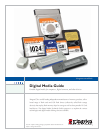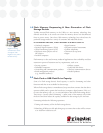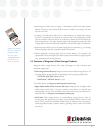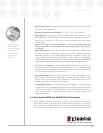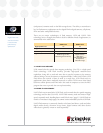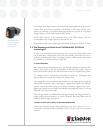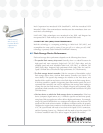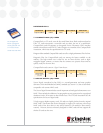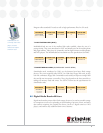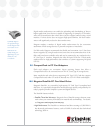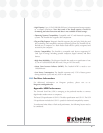
COMMITTED TO MEMORY
Intel Corporation has introduced NOR StrataFlash™; AMD has introduced NOR
MirrorBit™ Flash. Other semiconductor manufacturers also manufacture their own
multi-level cell technologies.
NAND MLC Flash technologies were introduced in late 2002, and Kingston has
incorporated MLC Flash memory into its line of standard Flash cards.
5.3 MULTI-BIT CELL (MBC) FLASH TECHNOLOGY
Multi-bit technology is a competing technology to Multi-Level Cell (MLC), and
accomplishes the same goal by storing 2 bits per cell (or 4 values per cell). MBC
technology is presently used in Infineon’s TwinFlash™ memory.
Flash Storage Device Performance
Flash card storage device performance depends on the following three factors:
• The specific Flash memory chips used: Generally, there is a tradeoff between the
high-speed and more expensive Single-Level Cell (SLC) flash chips, and the
standard speed and more affordable Multi-Level Cell (MLC) or Multi-Bit Cell
(MBC) flash chips. Kingston’s high performance flash cards (Elite Pro) and Hi-
Speed USB flash drives all utilize the high-performance SLC Flash memory.
• The Flash storage device’s controller: With the exception of SmartMedia, today’s
flash storage devices have a built-in flash memory controller (see Section 7 for
more details). This special chip manages the interface to the host device, and
handles all the reads from and writes to the flash chips on the flash storage device.
If the host controller is capable of supporting faster data transfer speeds, the use of
optimized flash controllers can result in significant time savings when reading or
writing data into the flash memory. For example, Kingston uses optimized, high-
performance flash controllers in its Elite Pro Flash cards and DataTraveler Hi-Speed
USB flash drives.
• The host device to which the Flash storage device is connected to: If the host
device (computer, digital camera, etc.) is limited to specific read and write speeds,
using faster Flash storage devices will not deliver higher performance. For example,
using a Hi-Speed USB flash drive on a computer that supports only the slower USB
speeds will not result in faster transfers. In addition, computers need to be properly
configured to support faster transfers in both hardware and software. In the case of
a PC, the system board will need to have built-in Hi-Speed USB 2.0 connectors,
and the Operating System (e.g., Windows) will also need to have the proper USB
2.0 drivers installed in order to be able to support Hi-Speed USB transfers.
USB flash memory
offers an easy way
to transfer files from
a digital device to
a computer.
FLASH MEMORY KINGSTON TECHNOLOGY 8
kingston.com/flash
6.0



